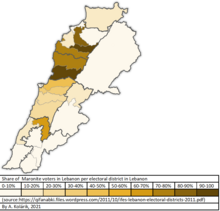 Distribution of Maronite Catholic Christians in Lebanon | |
| Languages | |
|---|---|
| Vernacular: Lebanese Arabic; historically Lebanese Aramaic Liturgical: Classical Syriac | |
| Religion | |
| Christianity (Maronite Catholic) |
| Part of a series of articles on |
| Lebanese people |
|---|
 |
|
|
Lebanese Maronite Christians (Arabic: المسيحية المارونية في لبنان; Classical Syriac: ܡܫܝܚܝ̈ܐ ܡܪ̈ܘܢܝܐ ܕܠܒܢܢ) refers to Lebanese people who are members of the Maronite Church in Lebanon, the largest Christian denomination in the country.[1] The Lebanese Maronite population is concentrated mainly in Mount Lebanon and East Beirut.[2] They are believed to constitute about 30% of the total population of Lebanon.[1]
The Maronites and the Druze founded modern Lebanon in the early eighteenth century through the ruling and social system known as the "Maronite–Druze dualism".[3] The 1860 Druze–Maronite conflict led to the establishment of Mount Lebanon Mutasarrifate, an autonomous entity within the Ottoman Empire dominated by Maronites and protected by European powers. In the aftermath of the First World War, the Maronites successfully campaigned for Greater Lebanon carved out from Mount Lebanon and neighboring areas. Under the French Mandate, and until the end of the Second World War, the Maronites gained substantial influence. Post-independence, they dominated Lebanese politics until the 1975–1990 civil war, which ended their supremacy. While the Taif Accords weakened Maronite influence, it endures alongside other dominant Lebanese communities, such as the Shiites and Sunnis.[2]
Lebanon's constitution was intended to guarantee political representation for each of the nation's religious groups.[4] Under the terms of an unwritten agreement known as the National Pact between the various political and religious leaders of Lebanon, the president of the country must be a Maronite.[5]
- ^ a b Department Of State. The Office of Electronic Information, Bureau of Public Affairs (19 September 2008). "Lebanon". 2001-2009.state.gov. Retrieved 15 November 2022.
- ^ a b Najem, Tom; Amore, Roy C.; Abu Khalil, As'ad (2021). Historical Dictionary of Lebanon. Historical Dictionaries of Asia, Oceania, and the Middle East (2nd ed.). Lanham Boulder New York London: Rowman & Littlefield. pp. 205–206. ISBN 978-1-5381-2043-9.
- ^ Deeb, Marius (2013). Syria, Iran, and Hezbollah: The Unholy Alliance and Its War on Lebanon. Hoover Press. ISBN 9780817916664.
the Maronites and the Druze, who founded Lebanon in the early eighteenth century.
- ^ Jamie Stokes, ed. (2009). Encyclopedia of the Peoples of Africa and the Middle East. Facts On File, Incorporated: Infobase Publishing. p. 447. ISBN 978-1-4381-2676-0.
- ^ "Programme on Governance in the Arab Region: Elections: Lebanon". United Nations Development Programme. Archived from the original on 18 July 2011. Retrieved 25 January 2010.